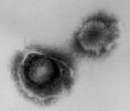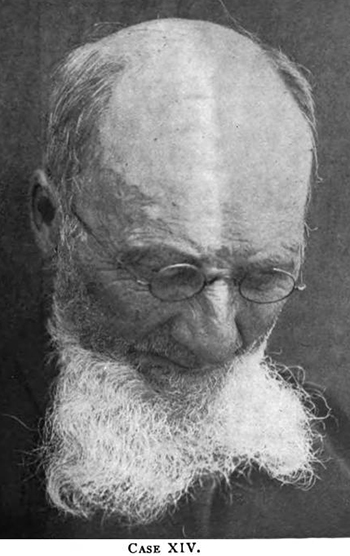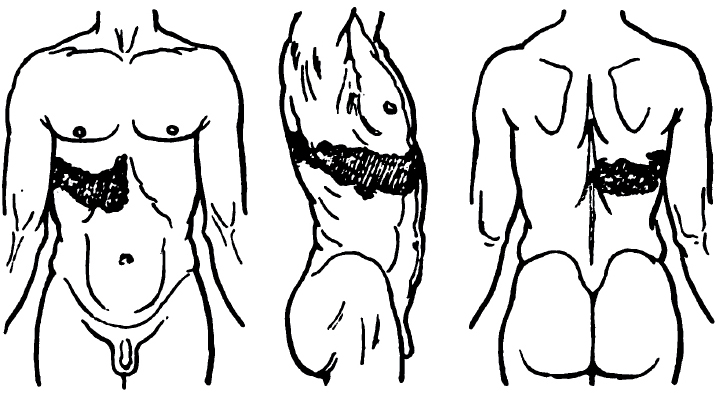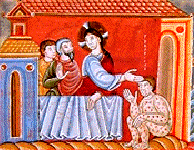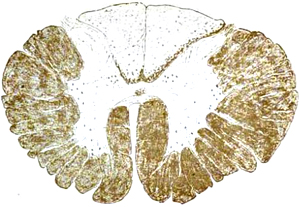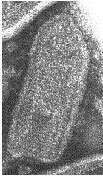- Causative organism
- US: Borrelia burgdorferi
- Europe
- Borrelia garinii: Associated with common neural involvement
- Borrelia afzelii
- B. burgdorferi sensu stricto
- Type of organism: Spirochete
- Vector: Bites of hard-shelled Ixodes ticks
- Tick types: I. scapularis in United States; I. ricinus in Europe
- Infections most common in late summer & autumn
- Transmission requires 36 hours of tick attachment
- Ingested blood triggers spirochete proliferation in tick gut
- Spirochete is disseminated in tick
- Spirochete is injected into host
- Epidemiology
- Age: Bimodal; Children (5 to 14 years); Adults (30 to 49 years)
- Peak: Late Summer & Early Fall
- Geography (US): 95% in
- Eastern coastal states from District of Columbia to Vermont/New Hampshire
- Wisconsin & Minnesota
- Occasional cases in California
- Clinical features
- Skin rash: Early & local
- Onset: Within 1 month of infection
- Erythema migrans rash
- Erythematous macule or papule
- Not painful or pruritic
- Progression
- Centrifugally expanding
- Spirochetes often present in leading edge
- Acute disseminated disease: With systemic spread of spirochete
- Hematogenous dissemiantion
- Particularly with US strains
- Often results in a multifocal rash
- Each focus represents a separate nidus of metastatic infection
- Other organs infected: Joints; Heart; Meninges & Peripheral nerve
- General clinical featues during dissemination
- Flu-like syndrome: Fever, Myalgias, Fatigue, Arthralgias, Headache
- No associated upper respiratory or gastrointestinal symptoms
- Meningoradiculitis (Bannwarth syndrome)
- Headache, Meningismus
- Radicular pain: Upper trunk & back
- Focal weakness
- Few sensory signs
- Course: Relapsing
- Neurologic
- Cardiac: A-V block, Pericarditis, Dilated cardiomyopathy
- Arthritis: Oligoarticular
- Onset days to years after infection
- Often relapsing - remitting
- Occur in 60% of cases
- Latency: 3 to 30 days
- Neurologic manifestations (Neuroborreliosis)
- Frequency: In 10% to 40% of Borrelia burgdorferi infections
- Central Nervous System
- Aseptic meningitis syndrome
- Encephalomyelitis: Often with focal features & fatigue
- Transverse myelitis
- Early in disease course
- Progressive over weeks
- Focal disorders
- Distribution: Cranial nerves; Peripheral nerves & Roots
- Onset: Early (First 1 or 2 months) during infection
- Acute onset
- Often associated with lymphocytic meningitis.
- Course
- Usually self-limited
- May resolve more rapidly with antibiotic treatment
- Cranial nerve syndromes
- Distribution
- Facial (VII) most common
- Multiple: 15% to 20%; Bilateral facial in 75%
- Involvement of all cranial nerves except olfactory described
- Frequency: 40% of neuroborreliosis
- Facial palsy
- In 10% of untreated patients
- Unilateral or Bilateral
- May not involve taste or hyperacusis
- May be common cause of VII palsy in children in endemic areas
- Full recovery in 85% with treatment
- Borrelia burgdorferi antigen in CSF
- May occur early in disease course
- Some: Before antibody testing becomes positive
- Other: Most often III, V & VI
- Peripheral nerve syndromes
- Multifocal radiculoneuropathy in acute disseminated stage
- Onset: Subacute; Burning radicular pain
- Pain distribution
- Dermatomal, Thoracolumbar or Distal
- May involve limb with tick bite
- More common in Europe than US
- Asymmetric
- Radicular involvement more common in Europe than US
- Patterns of subacute involvement: Other
- Laboratory
- CSF: Pleocytosis
- Nerve conduction: Axonal loss
- EMG: Denervation, In distal, proximal or paraspinous muscles
- Chronic disease
- Distal sensory-motor neuropathy
- Carpal tunnel syndrome
- More common in Europe & Elderly
- Onset: 6 months to 8 years after infection
- Nerve conduction: Axonal loss
- Nerve biopsy: Perivascular inflammation
- Late disease with Acrodermatitis chronica atrophicans (ACA)
4
- Patient age: Average 70's; Range 55 to 84
- Skin lesions
- Bluish-red inflammatory skin lesion: Localized to acral extremities
- Patients: Elderly female predominance
- Exaggerated pain (Allodynia)
- Location: Bony prominences underlying ACA lesions
- Elevated serum IgG antibodies to B. burgdorferi
- Polyneuropathy
- Sensory loss: Especially vibration
- Distribution: Symmetric, Distal
- Mild
- Motor: Normal
- Electrophysiology: Axonal loss
- Nerve pathology
- Loss of large & small myelinated axons
- Occasional perivascular inflammation
- Lyme myositis
21
- Frequency in Lyme disease: Unusual
- Muscle involvement: Localized
- Asymmetric
- Swelling: Muscle & Limb
- Painful
- May be near cutaneous lesions
- Ocular myositis: Some patients
- Dermatomyositis-like disorder: Rare
- Other clinical
- Contiguous monoarthritis
- Cardiac disorders
- Laboratory
- Serum CK: Usually normal
- MRI of involved muscle: Diffuse T2 signal
- Muscle biopsy: Inflammation
- Location: Often near small blood vessels; Perimysial
- Cell types
- Monocellular, lymphoplasmacytic & histiocytic
- Macrophages & T helper/inducer (CD4+) cells
- Muscle fibers: Scattered or abundant necrosis
- Perimysium: Thickened
- Histologic staining for spirochetes
- Treatment: Antibiotic regimens
- Diagnosis
- Laboratory
- CSF: Mononuclear pleocytosis; Moderately elevated protein
- Diagnosis
- Culture: From edge of skin lesion; Blood culture is low yield
- Serology: Variable specificity & sensitivity
- ELISA confirmed by Western blot
- Western blot: Binding to specific bands
- Intrathecal Borrelia burgdorferi antibodies
- Meningitis: 92%
- Late CNS: 42%
- Seronegativity (7%)
- Early in disease course
- Antibiotic treatment: Noncurative doses early in infection
- Antibody complex
- May not indicate ongoing infection
- Positive serologic result may reflect infection or exposure in past
- False-positive: May occur with
- Response to microbiologically similar organisms
- Nonspecific B-cell proliferation with systemic inflammation
- Endocarditis, Bacterial
- SLE
- Vasculitis
- Western blot
- Can verify US results
- European strains: Too much variability
- DNA assay (PCR) of Borrelia burgdorferi antigen in body fluids
- Treatment
- Early & Local disease: 21 days oral
- Amoxicillin 500 mg to 1 g tid, or
- Doxycycline 100 mg bid
- NOTE: Not for children under 8 years, or pregnant or lactating women.
- Other neurologic: Intravenous for 2 to 4 weeks
- Ceftriaxone 1g bid (2 g per day) for 2 to 4 weeks
- Cefotaxime 2 gms tid for 14-28 days
- Penicillin 20 to 24 million units per day for 14-28 days
- Chloramphenicol: Penicillin allergy
- High-dose oral
- Effective in European patients with meningitis or cranial neuritis
- Doxycycline 200-400 mg/d for 21-42 days
- Herxheimer reaction in 10% to 20%
- Prognosis: Good recovery with (or rarely without) antibiotics
- Animal model of neuroborreliosis
- Rhesus macaque monkey: Often develops mononeuritis multiplex
- External links
|
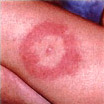
From
ALDF
|
Erythema
migrans |
|
